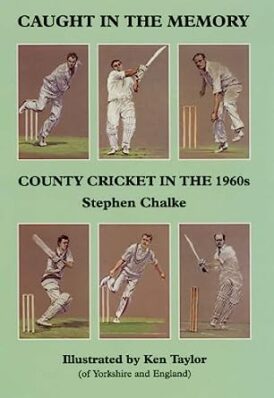Caught in the Memory: County Cricket in the 1960s
David Taylor |Published: 1999
Pages: 224
Author: Chalke, Stephen
Publisher: Fairfield Books
Rating: 4 stars

Sixteen years ago, no less, I had the pleasure of reading and reviewing the companion piece to this book – Runs in the Memory, published two years earlier and covering the Fifties. I guessed it must have been a long time ago, because I passed the book on to my Dad, and he’s been gone thirteen years – needless to say, he thoroughly enjoyed it. This one, for some reason, is considerably harder to find. For many years I frequented the book stall at Canterbury, and always asked if they had it – only to be disappointed. I could of course have sourced a copy from the internet, but as luck would have it I was at the St Lawrence ground last month – there’s a different bookseller there now – and there it was. I practically snapped his arm off for a tenner.
If you’ve read ‘Runs’ – and if you haven’t it’s an easy one to get hold of – you will be familiar with the premise. Chalke sat down with county players from the Sixties, allowing them to talk through a dozen games in which they took part, and their memories of team-mates, grounds, even supporters. As one put it, “it’s funny what you remember.” One-day cricket appeared in 1963 in the form of the Gillette Cup, and that is touched on, but these are all Championship games. They’re discussed in the present tense, in short paragraphs, interspersed with news reports from the outside world. Several, but not all of the matches are close finishes. Of course, there has to be a Roses match. It’s entitled Lancashire, you’ve lost – ah, but did they?
By the end of the book overseas players are making their mark and at one point we have Mike Procter bowling to Barry Richards, but for the most part these are journeyman players, not Test stars. They have provided us with some wonderful characters. ‘Bomber’ Wells was renowned for how quickly he could bowl an over. As one team-mate put it, he was once walking back to his mark at third man when the ball passed him on the way to the boundary. “And it wasn’t even the first ball of the over.” The book is nostalgic and often wistful in tone. Alan Oakman talks about the Hastings ground, which had a shopping centre built on it; “I was standing in Marks and Spencers, trying to work out where I used to bat, but I couldn’t manage it with all the clothes around.”
A recurring theme is the shortage of money, for clubs as well as players. One-day cricket helped in that regard and enabled most counties to sign an overseas pro a few years later. They may not have had much cash but they seem to have plenty of fun. I wonder if it is still so for their successors. I must add at this point the wonderful portraits by Ken Taylor, formerly of Yorkshire and England, whose work also adorned the earlier publication. Inevitably, most of the players interviewed are no longer with us 24 years on – though happily Robin Hobbs, Mike Willett, Alan Castell and Brian Jackson are still around.
There’s one extraordinary incident which is mentioned in passing, and of which I wasn’t aware – in 1962 Surrey’s Dick Jefferson hit Hampshire spinner Mervyn Burden for sixes from the first four balls of the over, before acting skipper Micky Stewart called them in! Even the bowler wanted to continue. Stay and put us into Wisden he called out. Six years later one GS Sobers did just that at Cardiff.
Much as I would like to endow a fifth star, it’s no use pretending a book like this would have universal appeal today. Fans of The [gritted teeth] Hundred will find little to interest them – so Joe Root’s ghosted autobiography it is, then. Hopefully one day they’ll realise that nostalgia is everything it used to be.






Leave a comment